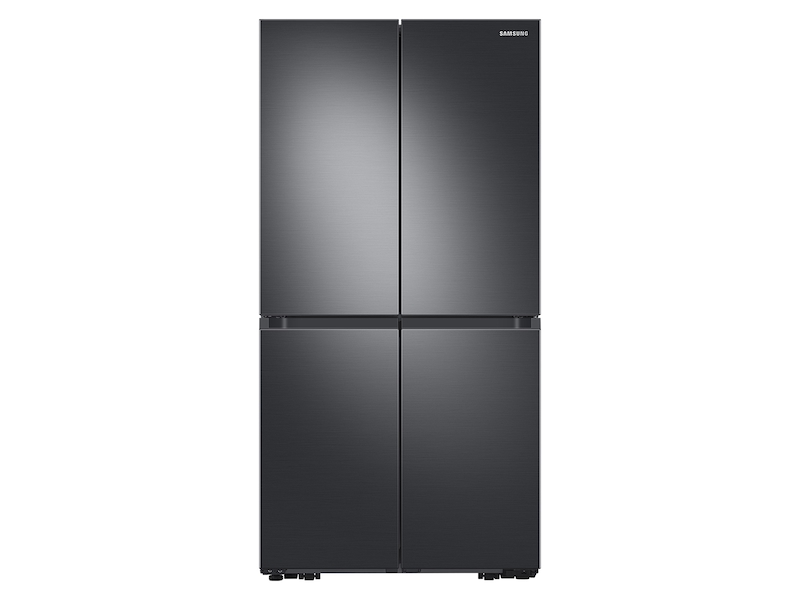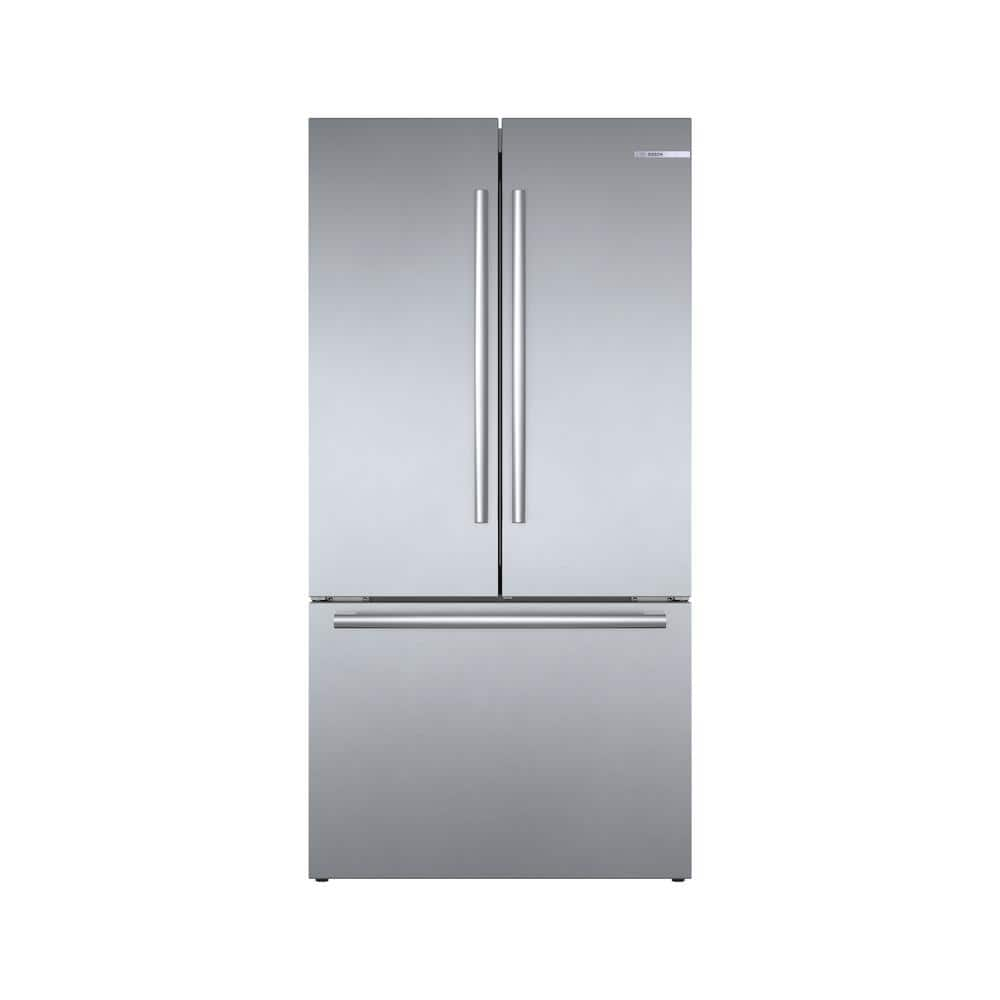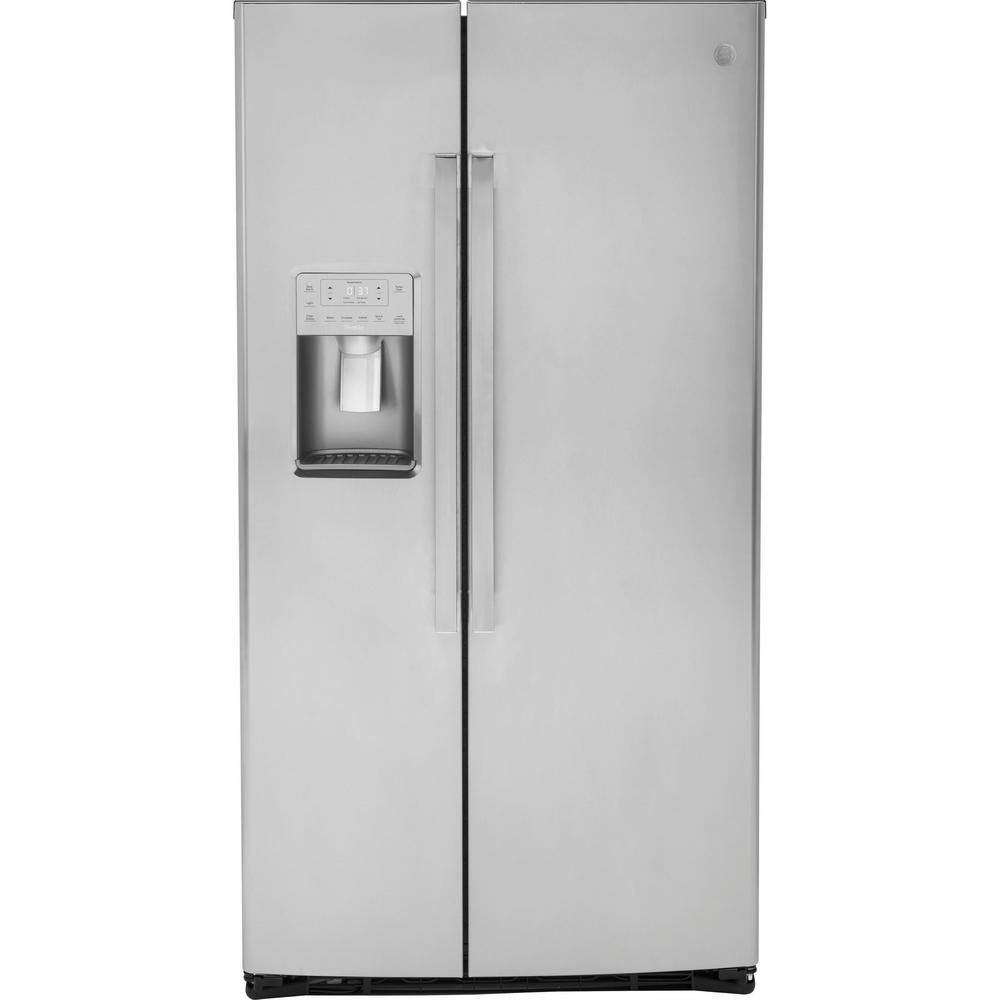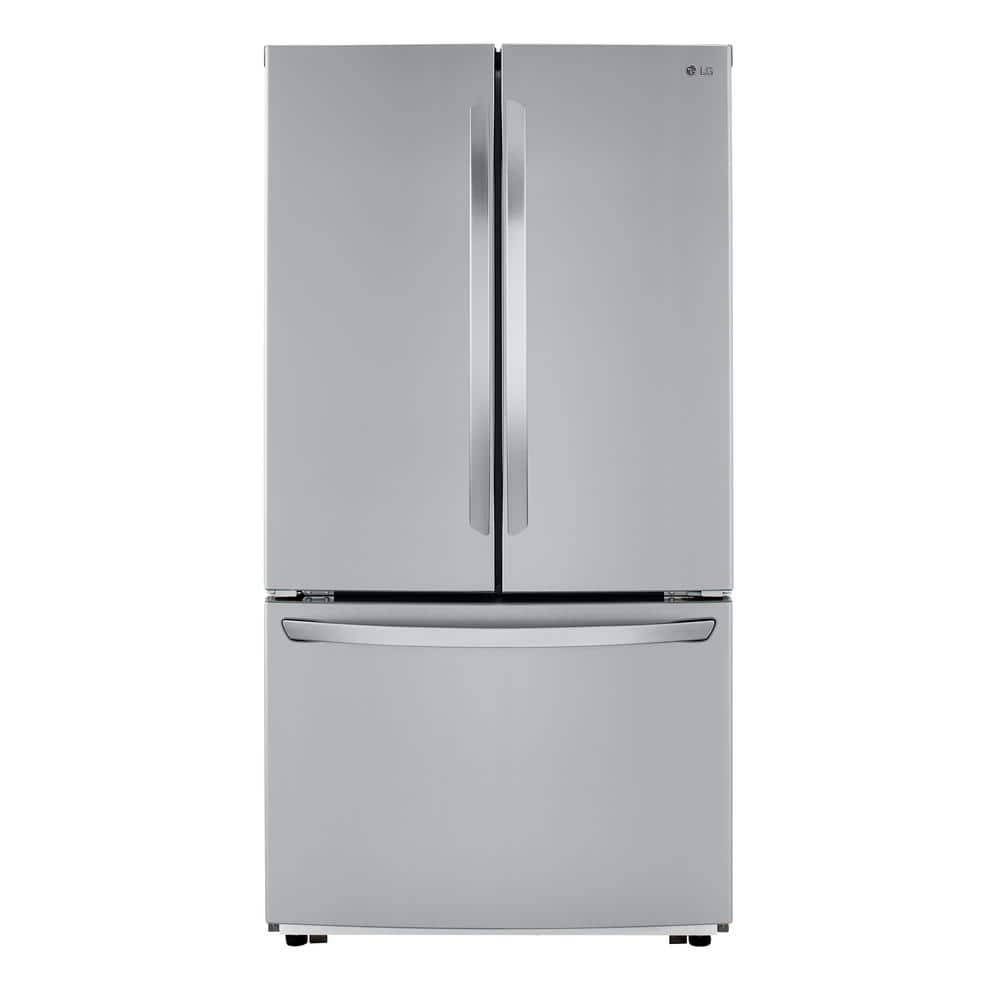Samsung 27.8 cu. ft. Food Showcase 4-Door French Door Refrigerator in Fingerprint Resistant Black Stainless
Food Showcase Door: Provides quick access to everyday items. FlexZone Drawer: flexible storage with four temperature settings. Wi-Fi and Bixby Enabled: Control and monitor your fridge remote.
A refrigerator that is beautifully designed, with an modern dispenser, polished door, and sleek handles. The Food Showcase Door provides quick access to on-the-go items. Now available in beautiful Tuscan Stainless.
- Food Showcase Door – Provides quick access to everyday items while minimizingthe loss of cool air
- FlexZone Drawer – Aflexible storage drawer with four different temperature settings and an adjustable Smart Divider to stay organized
- Adjustable Shelves – Adjustable shelves go from standard to slide-in or flip-up, to store tall items with ease
- Wi-Fi and Bixby Enabled – Use your smartphone tocontrol the temperature and monitor your refrigerator remotely
- AutoFill Water Pitcher – A built-in pitcher that automatically refills with filtered water and the option to infuse with a flavor of your choice
- Fingerprint Resistant Finish – A special finish to reduce smudges and minimize cleaning
- High-Efficiency LED lighting designed to beautifully light up the interior of your fridge so youre able to quickly spot what you want
- Accessibility (ADA Compliant) – Easy to reach controls for everyone
- Twin Cooling Plus – Near-commercial grade humidity levels, helps prevent spoiling and freezer burn
- Metal Cooling – Stainless steel paneling maintains consistent temperature throughout the refrigerator
- Ice Max – Large capacity, storesup to 10 lbs. of ice
- ENERGY STAR Certified – Eco-friendly and energy-efficient
Additional information
| Depth (Excluding Handles) (in.) | 34 |
|---|---|
| Depth (Including Handles) (in.) | 36.5 |
| Depth (Less Door) (in.) | 29.4 |
| Depth With Door Open 90 Degrees (In) | 48.25 |
| Height to Top of Door Hinge (in.) | 70 |
| Height to Top of Refrigerator (in.) | 68.9 |
| Product Depth x Height x Width (in.) | 36.5 x 70 x 35.75 |
| Refrigerator Width (In.) | 35.75 |
| Certifications and Listings | ADA Compliant,Energy Star |
| Manufacturer Warranty | Five (5) years Parts and Labor on sealed Refrigeration system only*Ten (10) years Part and Five (5) years Labor on Digital Inverter Compressor(*Compressor, evaporator, condenser, drier, connecting tubing) |
27 may refer to:
- 27 (number), the natural number following 26 and preceding 28
- one of the years 27 BC, AD 27, 1927, 2027
4 (four) is a number, numeral and digit. It is the natural number following 3 and preceding 5. It is a square number, the smallest semiprime and composite number, and is considered unlucky in many East Asian cultures.
Black is a color that results from the absence or complete absorption of visible light. It is an achromatic color, without hue, like white and grey. It is often used symbolically or figuratively to represent darkness. In Western society, black and white have often been used to describe opposites such as good and evil, the Dark Ages versus Age of Enlightenment, and night versus day. In Western society, since the Middle Ages, black has been the symbolic color of solemnity and authority, and for this reason it is still commonly worn by judges and magistrates.
Black was one of the first colors used by artists in Neolithic cave paintings. It was used in ancient Egypt and Greece as the color of the underworld. In Ancient Egypt, black had positive associations; being the color of fertility and the rich black soil flooded by the Nile. In the Roman Empire, it became the color of mourning, and over the centuries it was frequently associated with death, evil, witches, and magic. In the 14th century, it was worn by royalty, clergy, judges, and government officials in much of Europe. It became the color worn by English romantic poets, businessmen and statesmen in the 19th century, and a high fashion color in the 20th century. According to surveys in Europe and North America, it is the color most commonly associated with mourning, the end, secrets, magic, force, violence, fear, evil, and elegance.
Black is the most common ink color used for printing books, newspapers and documents, as it provides the highest contrast with white paper and thus is the easiest color to read. Similarly, black text on a white screen is the most common format used on computer screens. As of September 2019, the darkest material is made by MIT engineers from vertically aligned carbon nanotubes.
A door is a hinged or otherwise movable barrier that allows ingress (entry) into and egress (exit) from an enclosure. The created opening in the wall is a doorway or portal. A door's essential and primary purpose is to provide security by controlling access to the doorway (portal). Conventionally, it is a panel that fits into the doorway of a building, room, or vehicle. Doors are generally made of a material suited to the door's task. They are commonly attached by hinges, but can move by other means, such as slides or counterbalancing.
The door may be able to move in various ways (at angles away from the doorway/portal, by sliding on a plane parallel to the frame, by folding in angles on a parallel plane, or by spinning along an axis at the center of the frame) to allow or prevent ingress or egress. In most cases, a door's interior matches its exterior side. But in other cases (e.g., a vehicle door) the two sides are radically different.
Many doors incorporate locking mechanisms to ensure that only some people can open them (such as with a key). Doors may have devices such as knockers or doorbells by which people outside announce their presence. (In some countries, such as Brazil, it is customary to clap from the sidewalk to announce one's presence.) Apart from providing access into and out of a space, doors may have the secondary functions of ensuring privacy by preventing unwanted attention from outsiders, of separating areas with different functions, of allowing light to pass into and out of a space, of controlling ventilation or air drafts so that interiors may be more effectively heated or cooled, of dampening noise, and of blocking the spread of fire.
Doors can have aesthetic, symbolic, ritualistic purposes. Receiving the key to a door can signify a change in status from outsider to insider. Doors and doorways frequently appear in literature and the arts with metaphorical or allegorical import as a portent of change.
A fingerprint is an impression left by the friction ridges of a human finger. The recovery of partial fingerprints from a crime scene is an important method of forensic science. Moisture and grease on a finger result in fingerprints on surfaces such as glass or metal. Deliberate impressions of entire fingerprints can be obtained by ink or other substances transferred from the peaks of friction ridges on the skin to a smooth surface such as paper. Fingerprint records normally contain impressions from the pad on the last joint of fingers and thumbs, though fingerprint cards also typically record portions of lower joint areas of the fingers.
Human fingerprints are detailed, nearly unique, difficult to alter, and durable over the life of an individual, making them suitable as long-term markers of human identity. They may be employed by police or other authorities to identify individuals who wish to conceal their identity, or to identify people who are incapacitated or deceased and thus unable to identify themselves, as in the aftermath of a natural disaster.
Their use as evidence has been challenged by academics, judges and the media. There are no uniform standards for point-counting methods, and academics have argued that the error rate in matching fingerprints has not been adequately studied and that fingerprint evidence has no secure statistical foundation. Research has been conducted into whether experts can objectively focus on feature information in fingerprints without being misled by extraneous information, such as context.
Food is any substance consumed by an organism for nutritional support. Food is usually of plant, animal, or fungal origin and contains essential nutrients such as carbohydrates, fats, proteins, vitamins, or minerals. The substance is ingested by an organism and assimilated by the organism's cells to provide energy, maintain life, or stimulate growth. Different species of animals have different feeding behaviours that satisfy the needs of their metabolisms and have evolved to fill a specific ecological niche within specific geographical contexts.
Omnivorous humans are highly adaptable and have adapted to obtain food in many different ecosystems. Humans generally use cooking to prepare food for consumption. The majority of the food energy required is supplied by the industrial food industry, which produces food through intensive agriculture and distributes it through complex food processing and food distribution systems. This system of conventional agriculture relies heavily on fossil fuels, which means that the food and agricultural systems are one of the major contributors to climate change, accounting for as much as 37% of total greenhouse gas emissions.
The food system has significant impacts on a wide range of other social and political issues, including sustainability, biological diversity, economics, population growth, water supply, and food security. Food safety and security are monitored by international agencies like the International Association for Food Protection, the World Resources Institute, the World Food Programme, the Food and Agriculture Organization, and the International Food Information Council.
French may refer to:
- Something of, from, or related to France
- French language, which originated in France
- French people, a nation and ethnic group
- French cuisine, cooking traditions and practices
A refrigerator, colloquially fridge, is a commercial and home appliance consisting of a thermally insulated compartment and a heat pump (mechanical, electronic or chemical) that transfers heat from its inside to its external environment so that its inside is cooled to a temperature below the room temperature. Refrigeration is an essential food storage technique around the world. The low temperature lowers the reproduction rate of bacteria, so the refrigerator reduces the rate of spoilage. A refrigerator maintains a temperature a few degrees above the freezing point of water. The optimal temperature range for perishable food storage is 3 to 5 °C (37 to 41 °F). A similar device that maintains a temperature below the freezing point of water is called a freezer. The refrigerator replaced the icebox, which had been a common household appliance for almost a century and a half. The United States Food and Drug Administration recommends that the refrigerator be kept at or below 4 °C (40 °F) and that the freezer be regulated at −18 °C (0 °F).
The first cooling systems for food involved ice. Artificial refrigeration began in the mid-1750s, and developed in the early 1800s. In 1834, the first working vapor-compression refrigeration, using the same technology seen in air conditioners, system was built. The first commercial ice-making machine was invented in 1854. In 1913, refrigerators for home use were invented. In 1923 Frigidaire introduced the first self-contained unit. The introduction of Freon in the 1920s expanded the refrigerator market during the 1930s. Home freezers as separate compartments (larger than necessary just for ice cubes) were introduced in 1940. Frozen foods, previously a luxury item, became commonplace.
Freezer units are used in households as well as in industry and commerce. Commercial refrigerator and freezer units were in use for almost 40 years prior to the common home models. The freezer-over-refrigerator style had been the basic style since the 1940s, until modern, side-by-side refrigerators broke the trend. A vapor compression cycle is used in most household refrigerators, refrigerator–freezers and freezers. Newer refrigerators may include automatic defrosting, chilled water, and ice from a dispenser in the door.
Domestic refrigerators and freezers for food storage are made in a range of sizes. Among the smallest are Peltier-type refrigerators designed to chill beverages. A large domestic refrigerator stands as tall as a person and may be about one metre (3 ft 3 in) wide with a capacity of 0.6 m3 (21 cu ft). Refrigerators and freezers may be free standing, or built into a kitchen. The refrigerator allows the modern household to keep food fresh for longer than before. Freezers allow people to buy perishable food in bulk and eat it at leisure, and make bulk purchases.
Samsung Group (Korean: 삼성; Hanja: 三星; RR: samseong [samsʌŋ]; stylized as SΛMSUNG) is a South Korean multinational manufacturing conglomerate headquartered in Samsung Digital City, Suwon, South Korea. It comprises numerous affiliated businesses, most of them united under the Samsung brand, and is the largest South Korean chaebol (business conglomerate). As of 2020, Samsung has the world's eighth-highest brand value.
Samsung was founded by Lee Byung-chul in 1938 as a trading company. Over the next three decades, the group diversified into areas including food processing, textiles, insurance, securities, and retail. Samsung entered the electronics industry in the late 1960s and the construction and shipbuilding industries in the mid-1970s; these areas would drive its subsequent growth. Following Lee's death in 1987, Samsung was separated into five business groups – Samsung Group, Shinsegae Group, CJ Group and Hansol Group, and JoongAng Group.
Notable Samsung industrial affiliates include Samsung Electronics (the world's largest information technology company, consumer electronics maker and chipmaker measured by 2017 revenues), Samsung Heavy Industries (the world's second largest shipbuilder measured by 2010 revenues), and Samsung Engineering and Samsung C&T Corporation (respectively the world's 13th and 36th largest construction companies). Other notable subsidiaries include Samsung Life Insurance (the world's 14th largest life insurance company), Samsung Everland (operator of Everland Resort, the oldest theme park in South Korea) and Cheil Worldwide (the world's 15th largest advertising agency, as measured by 2012 revenues).
Showcase or vitrine most often refers to:
- Display case, a glass case for the display and protection of articles in shops or museums
Showcase may also refer to:
Stainless may refer to:
- Cleanliness, or the quality of being clean
- Stainless steel, a corrosion-resistant metal alloy
- Stainless Games, a British video game developer
- Stainless Broadcasting Company, a TV broadcaster based in Michigan, US
- Stainless Banner, the second national flag of the Confederate States of America







by Mike
The refrigerator is beautiful. There needs to be a more sturdy tube that goes on the back of the refrigerator for the water and icemaker. We noticed that it was leaking.
by Butler
This fridge runs great. The easy access door is very convenient. We’ve had it for about a month now and it runs like a dream.
by William
We love our new Samsung Refrigerator.
by John
Getting this and a stove was an ordeal. Cut any future dealings with HomeDepot. Great fridge.
by David
so far we really like it. lots of room and convenience. the right ‘spare’ door was a bit stiff at first but seems to be loosening up and is handy. freezer seems huge. no ice maker down there but haven’t missed it. some of the electronic setting are a bit finicky but overall everything works well. big sale made it a great value. now it’s just how long will it last.